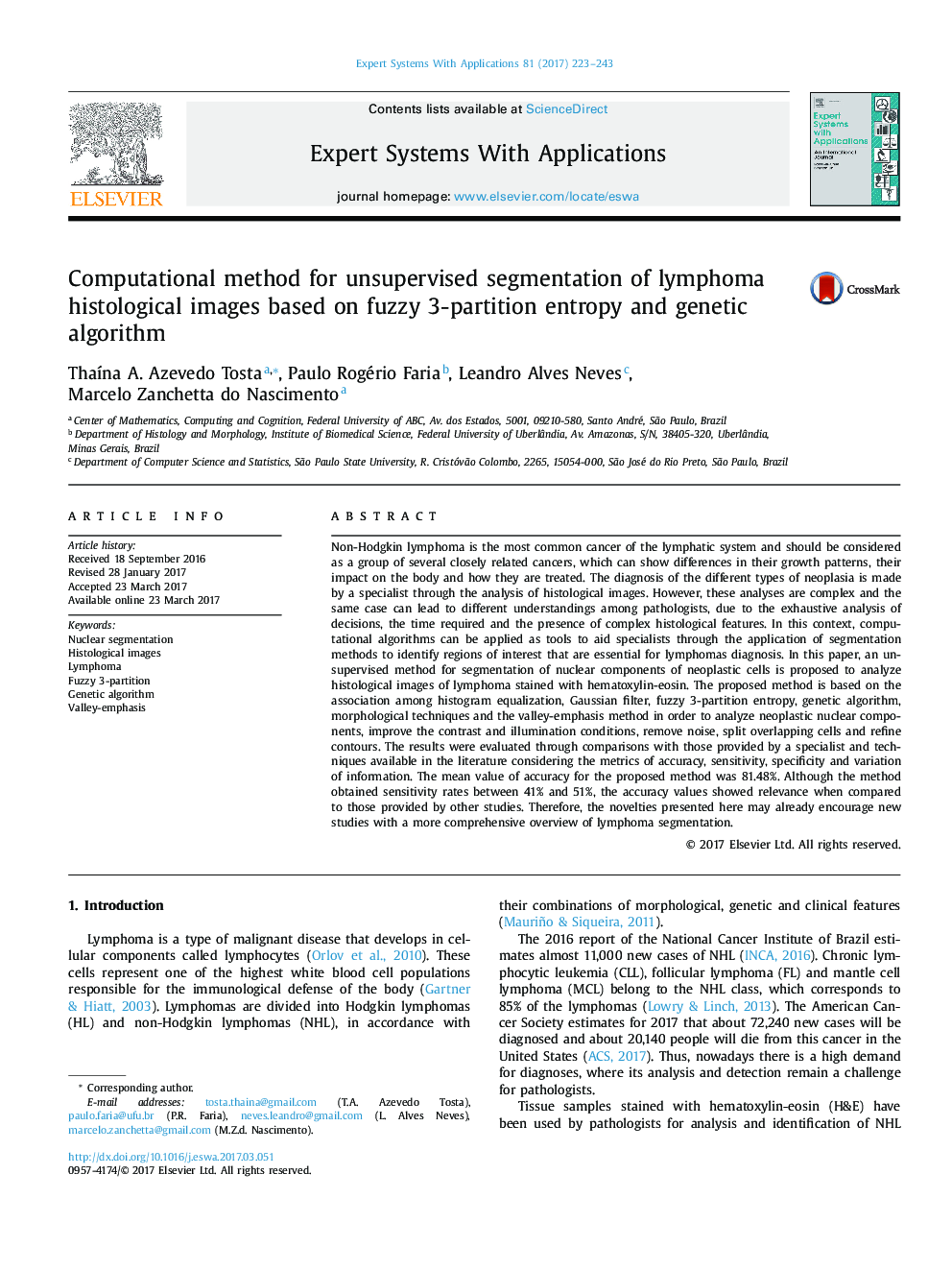| کد مقاله | کد نشریه | سال انتشار | مقاله انگلیسی | نسخه تمام متن |
|---|---|---|---|---|
| 4943357 | 1437625 | 2017 | 21 صفحه PDF | دانلود رایگان |
عنوان انگلیسی مقاله ISI
Computational method for unsupervised segmentation of lymphoma histological images based on fuzzy 3-partition entropy and genetic algorithm
ترجمه فارسی عنوان
روش محاسبه برای جداسازی نا منظم از تصاویر بافتشناسی لنفوم بر اساس آنتروپی فازی 3 پریت و الگوریتم ژنتیک
دانلود مقاله + سفارش ترجمه
دانلود مقاله ISI انگلیسی
رایگان برای ایرانیان
کلمات کلیدی
تقسیم بندی هسته ای، تصاویر بافت شناسی لنفوم، فازی 3 پارتیشن، الگوریتم ژنتیک، دره تاکید،
ترجمه چکیده
لنفوم غیر هوچکین شایعترین سرطان سیستم لنفاوی است و باید به عنوان گروهی از سرطانهای مرتبط با آن در نظر گرفته شود که میتواند تفاوت الگوهای رشد آنها، تأثیر آنها بر بدن و نحوه درمان آنها را نشان دهد. تشخیص انواع مختلف نئوپلاسی توسط متخصص از طریق تجزیه و تحلیل تصاویر بافت شناسی ساخته شده است. با این حال، این تجزیه و تحلیل ها پیچیده هستند و یک مورد می تواند منجر به درک متفاوتی در میان آسیب شناسان شود، به علت تجزیه و تحلیل جامع تصمیم ها، زمان لازم و حضور ویژگی های بافت شناسی پیچیده. در این زمینه، الگوریتم های محاسباتی می تواند به عنوان ابزار برای کمک به متخصصان از طریق استفاده از روش های تقسیم بندی برای شناسایی مناطق مورد علاقه است که برای تشخیص لنفوم ضروری است. در این مقاله، یک روش بدون نظارت برای تقسیم کردن اجزای هسته ای سلول های نئوپلاستیکی برای تجزیه و تحلیل تصاویر بافتی لنفوم رنگ آمیزی شده با هماتوکسیلین ائوزین پیشنهاد شده است. روش پیشنهادی براساس رابطه تساوی هیستوگرام، فیلتر گاوسی، آنتروپی فازی 3 پریتوری، الگوریتم ژنتیک، تکنیک های مورفولوژیکی و روش تناوب دره برای بررسی اجزای هسته ای نئوپلاستی، بهبود شرایط کنتراست و روشنایی، حذف نویز، تقسیم سلول های همپوشانی و تصحیح خطوط. نتایج حاصل از مقایسه با آنچه که توسط متخصص و تکنیک های موجود در ادبیات ارائه شده است با توجه به معیارهای دقت، حساسیت، ویژگی و تنوع اطلاعات ارزیابی می شود. میانگین دقت برای روش پیشنهادی 81/48 درصد بود. اگر چه روش حساسیت 41 تا 51 درصد را به دست آورد، اما مقادیر دقت در مقایسه با آنچه که توسط سایر مطالعات ارائه شده است، همبستگی پیدا می کند. بنابراین، نوآوری ارائه شده در اینجا ممکن است در حال حاضر مطالعات جدید را با یک بررسی جامع از تقسیم بندی لنفوم تشویق تشویق.
موضوعات مرتبط
مهندسی و علوم پایه
مهندسی کامپیوتر
هوش مصنوعی
چکیده انگلیسی
Non-Hodgkin lymphoma is the most common cancer of the lymphatic system and should be considered as a group of several closely related cancers, which can show differences in their growth patterns, their impact on the body and how they are treated. The diagnosis of the different types of neoplasia is made by a specialist through the analysis of histological images. However, these analyses are complex and the same case can lead to different understandings among pathologists, due to the exhaustive analysis of decisions, the time required and the presence of complex histological features. In this context, computational algorithms can be applied as tools to aid specialists through the application of segmentation methods to identify regions of interest that are essential for lymphomas diagnosis. In this paper, an unsupervised method for segmentation of nuclear components of neoplastic cells is proposed to analyze histological images of lymphoma stained with hematoxylin-eosin. The proposed method is based on the association among histogram equalization, Gaussian filter, fuzzy 3-partition entropy, genetic algorithm, morphological techniques and the valley-emphasis method in order to analyze neoplastic nuclear components, improve the contrast and illumination conditions, remove noise, split overlapping cells and refine contours. The results were evaluated through comparisons with those provided by a specialist and techniques available in the literature considering the metrics of accuracy, sensitivity, specificity and variation of information. The mean value of accuracy for the proposed method was 81.48%. Although the method obtained sensitivity rates between 41% and 51%, the accuracy values showed relevance when compared to those provided by other studies. Therefore, the novelties presented here may already encourage new studies with a more comprehensive overview of lymphoma segmentation.
ناشر
Database: Elsevier - ScienceDirect (ساینس دایرکت)
Journal: Expert Systems with Applications - Volume 81, 15 September 2017, Pages 223-243
Journal: Expert Systems with Applications - Volume 81, 15 September 2017, Pages 223-243
نویسندگان
ThaÃna A. Azevedo Tosta, Paulo Rogério Faria, Leandro Alves Neves, Marcelo Zanchetta do Nascimento,
